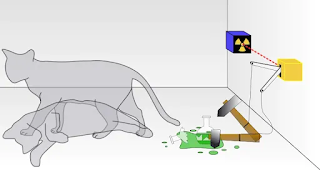Picture a cat trapped in a box that's slowly filling with a poisonous, radioactive gas. Is the cat alive or dead? This is not an exercise in morbidity, but rather a thought experiment devised in 1935 by Erwin Schrödinger, aimed at challenging the Copenhagen interpretation of quantum mechanics.
The Objective Behind Schrödinger’s Cat Paradox
The crux of this theoretical experiment is to illuminate the paradox that emerges from the cornerstone of the Copenhagen interpretation of quantum mechanics, a theory advanced by Bohr and Heisenberg. This interpretation describes microscopic systems as a superposition of varying physical states simultaneously (such as a potential decayed or undecayed atomic nucleus), until they interact with the external environment or are observed, causing the superposition to collapse into a solitary state.
The experiment postulates a cat inside an isolated box, with a mechanism capable of releasing lethal gas. The cat can't interfere with this mechanism, which can be triggered by a microscopic event such as the disintegration of an atomic nucleus. As per the Copenhagen interpretation, the atomic nucleus resides in a superposition of states until observed, at which point it may have decayed or remained intact.
The Paradox Revealed
If the nucleus decays, releasing a gamma photon, it may trigger the release of the poisonous gas, sealing the cat's fate. This links the cat's survival to the state of the atomic nucleus, leading to the paradox: The cat, representing a macroscopic system, would also exist in a simultaneous superposition of states, both alive and dead, until observed. This is a concept that challenges our daily macroscopic experiences.
To fully grasp this experiment, we shift focus from the cat and delve into the realm of particles, like electrons and protons, capable of existing in multiple states at once.
The Quantum Mechanics Phenomenon
Drawing a parallel between the cat and atoms, the cat could be simultaneously alive and dead. This seeming contradiction stems from quantum mechanics' inability to describe objects in a classical sense, instead resorting to a probabilistic representation. To illustrate that a particle can exist in multiple places, it is depicted as subject to a 'probability distribution' linked to the wave function, encompassing all possible positions. Only upon measuring the particle's position does its wave function 'collapse' into a specific spatial position.
Source: Griffiths, David J.; Schroeter, Darrell F. (2018). Introduction to quantum mechanics (3rd ed.). Cambridge: Cambridge University Press. ISBN 978-1-107-18963-8. OCLC 1030447903


Post a Comment